Related Research Articles

Tyrus Raymond Cobb, nicknamed "the Georgia Peach", was an American professional baseball center fielder. A native of rural Narrows, Georgia, Cobb spent 22 seasons in Major League Baseball (MLB) with the Detroit Tigers, the last six as the team's player-manager, and finished his career with the Philadelphia Athletics. In 1936, Cobb received the most votes of any player on the inaugural ballot for the National Baseball Hall of Fame, receiving 222 out of a possible 226 votes (98.2%); no other player received a higher percentage of votes until Tom Seaver in 1992. In 1999, the Sporting News ranked Cobb third on its list of "Baseball's 100 Greatest Players."

Charles Leonard Gehringer, nicknamed "the Mechanical Man", was an American professional baseball second baseman. He played for the Detroit Tigers for 19 seasons from 1924 to 1942. He compiled a .320 career batting average with 2,839 hits and 1,427 runs batted in (RBIs). He had seven seasons with more than 200 hits and was the starting second baseman and played every inning of the first six All Star Games. He won the American League batting title in 1939 with a .371 average and won the American League Most Valuable Player Award. He helped lead the Tigers to three American League pennants and the 1935 World Series championship.

Elmer Harrison Flick was an American professional baseball outfielder who played in Major League Baseball from 1898 to 1910 for the Philadelphia Phillies, Philadelphia Athletics, and Cleveland Bronchos/Naps. In 1,483 career games, Flick recorded a .313 batting average while accumulating 164 triples, 1,752 hits, 330 stolen bases, and 756 runs batted in (RBIs). He was elected to the Baseball Hall of Fame in 1963.

Napoléon"Nap"Lajoie, also known as Larry Lajoie, was an American professional baseball second baseman who played 21 seasons in Major League Baseball (MLB). Nicknamed "the Frenchman", he represented both Philadelphia franchises and the Cleveland Naps, the latter of which he became the namesake of, and from 1905 through 1909, the player-manager.
The 1935 World Series was the championship series in Major League Baseball for the 1935 season. The 32nd edition of the World Series, it matched the Detroit Tigers and the Chicago Cubs. The Tigers won in six games for their first championship in five Series appearances, as they had lost in 1907, 1908, 1909, and 1934. This was the first championship ever won by a Detroit-based team.
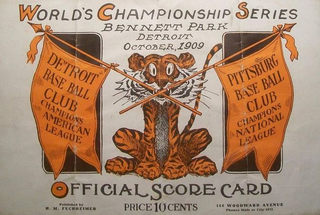
The 1909 World Series was the championship series in Major League Baseball for the 1909 season. The sixth edition of the World Series, it featured the National League champion Pittsburgh Pirates against the American League champion Detroit Tigers. The Pirates won the Series in seven games to capture their first championship of the modern Major League Baseball era and the second championship in the club's history. This Series is best remembered for featuring two of the very best players of the time, Pittsburgh shortstop Honus Wagner, and Detroit outfielder Ty Cobb.
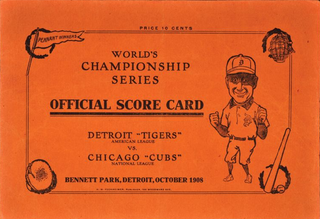
The 1908 World Series was the championship series in Major League Baseball for the 1908 season. The fifth edition of the World Series, it matched the defending National League champion Chicago Cubs against the American League champion Detroit Tigers in a rematch of the 1907 Series. In this first-ever rematch of this young event, the Cubs won in five games for their second straight World Series title.

The 1907 World Series was the championship series in Major League Baseball for the 1907 season. The fourth edition of the World Series, it featured the defending National League champion Chicago Cubs and the American League champion Detroit Tigers. The Cubs won the Series four games to none for their first championship.

Frederick George Lieb was an American sportswriter and baseball historian. Lieb published his memoirs in 1977, which documented his nearly 70 years as a baseball reporter. He received the J. G. Taylor Spink Award from the Baseball Writers' Association of America in 1972. Born in 1888 in Philadelphia, Lieb died at age 92 in Houston.

Victor Woodrow Wertz was an American professional baseball first baseman and outfielder. He had a 17-year Major League Baseball (MLB) career from 1947 to 1963. Wertz played for the Detroit Tigers, St. Louis Browns / Baltimore Orioles, Cleveland Indians, Boston Red Sox, and Minnesota Twins; all teams within the American League.

Robert Hayes Veach was an American professional baseball player from 1910 to 1930 including 14 seasons in the major leagues. He was the starting left fielder for the Detroit Tigers from 1912 to 1923 and also played for the Boston Red Sox (1924–1925), New York Yankees (1925), and Washington Senators (1925).
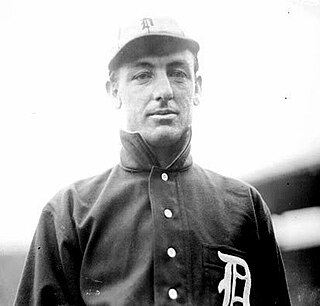
Charles Taylor Hickman was an American professional baseball player and college baseball coach. He played all or part of 12 seasons in Major League Baseball (MLB) as a utility player for seven different franchises, including over 200 games each with the Cleveland Bronchos / Naps, Washington Senators, and New York Giants. After his professional career, he coached the West Virginia Mountaineers baseball team for four seasons.

Harry Taylor Howell was an American professional baseball player who played as a pitcher for the Brooklyn Bridegrooms/Brooklyn Superbas, Baltimore Orioles (1899), Baltimore Orioles/New York Highlanders (1901–03), and St. Louis Browns (1904–10).
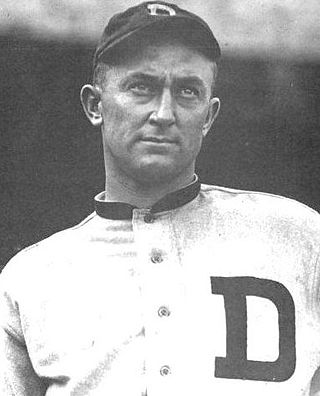
The 1915 Detroit Tigers won a club-record 100 games and narrowly lost the American League pennant to the Boston Red Sox, who won 101 games. Though four other Tigers teams have won 100 games, only the 1934 Tigers had a better winning percentage. The 1915 Detroit Tigers team is remembered for its all-star outfield of Ty Cobb, Sam Crawford, and Bobby Veach—who finished #1, #2, and #3 in the American League in both runs batted in and total bases. Baseball historian Bill James ranks the Tigers' 1915 outfield as the best in major league history.
The 1909 Detroit Tigers won the American League pennant with a record of 98–54, but lost to the Pittsburgh Pirates in the 1909 World Series, 4 games to 3. The season was their ninth since they were charter members of the American League in 1901. It was the third consecutive season in which they won the pennant but lost the World Series. Center fielder Ty Cobb won the Triple Crown and pitcher George Mullin led the league in wins (29) and winning percentage (.784).
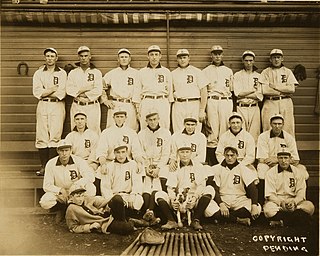
The 1907 Detroit Tigers won the American League pennant with a record of 92–58, but lost to the Chicago Cubs in the 1907 World Series, four games to none. The season was their seventh since they entered the American League in 1901.
The 1911 Cleveland Naps season was a season in American major league baseball. It involved the Cleveland Naps attempting to win the American League pennant and finishing in third place. They had a record of 80 wins and 73 losses.

In baseball, hitting for the cycle is the accomplishment of one batter who hits a single, a double, a triple, and a home run in the same game. Collecting the hits in that order is known as a "natural cycle". Cycles are rare in Major League Baseball (MLB), having occurred only 344 times, starting with Curry Foley in 1882. The most recent cycle in MLB was accomplished by José Altuve of the Houston Astros on August 28, 2023.

In baseball, pitching by position players refers to the act of a position player being used as a pitcher. A position player typically pitches when a game has a lopsided score or when the game has gone so far into extra innings that no other pitchers are available. The term is not used for a two-way player, a baseball player who is skilled at pitching and who plays another position.
References
- ↑ "SABR 45: Hildebrandt, Grilc win 2015 presentation awards". SABR. Retrieved April 17, 2017.
- ↑ Chuck Hildebrandt (June 27, 2015). 'Little League Home Runs' in MLB History (Speech). Chicago, Ill. Retrieved January 18, 2018.
- ↑ Tan, Cecilia M., ed. (2017). Baseball Research Journal, Volume 46 Number 1, Spring 2017. Phoenix, Ariz.: Society for American Baseball Research, Inc. p. 33. ISBN 978-1-943816-39-2.
- ↑ "Little League Home Runs Database". SABR. Retrieved January 18, 2018.
- ↑ "TIGERS PUSH OVER WINNING TALLY IN THIRTEENTH INNING". Detroit Free Press. Detroit Free Press, September 11, 1911. 11 September 1911. p. 8. Retrieved January 18, 2018.
- ↑ "Ryan's No-Hit Bid Ends in 8th". Los Angeles Times, June 2, 1974. Retrieved April 17, 2017.